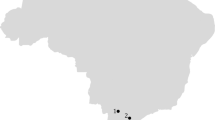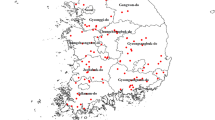Abstract
Purpose
The aim of this study is to identify and evaluate the main environmental impacts related to semi-intensive beef cattle production system in the State of Bahia, in Brazil’s Northeast.
Methods
A cradle to gate study was undertaken in a beef cattle production system comprising two stages: calves production in one farm (farm 1) and cattle production in another farm (farm 2), both located in the central-southern meso-region of Bahia. The functional unit was 1 kg live weight. Impact assessment was performed using five impact categories from the ReCiPe method.
Results and discussion
When compared to calves, the cattle production had the greatest contributions in all of the five studied impact categories. The process pasture cultivation had expressive environmental impacts in all categories, with 70.05 % for climate change (CC), 82.01 % for terrestrial acidification (TA), 76.53 % for fossil depletion (FD), 86.14 % for freshwater eutrophication (FE) and 100 % for agricultural land occupation (ALO). In CC and TA, the principal elementary flow was the direct emissions due to the use of mineral fertilizers. In FE and FD, the dominant flow was related to the use of phosphate fertilizer. In ALO, the process pasture cultivation was predominant due to the physical area of the farms, which is a characteristic of pasture-based production systems. The processes breeding-rearing and fattening were second in the contribution analysis, with 29.95 % and 17.99 %, respectively, for CC and TA, due to the enteric methane (CH4) and the direct emissions of nitrous oxide (N2O) volatilization from the animal excreta.
Conclusions
The cattle production is responsible for the greater part of impacts, compared to the calves production. The direct emissions from fertilizers used in the pastures, from enteric emissions and from animal wastes in the breeding-rearing and fattening processes were identified as the critical points of the analysed cattle production system. Measures aiming at the improvement of the feed conversion of the animals and at the substitution of synthetic nitrogen fertilizers by natural nitrogen fixation can considerably contribute to the reduction of environmental impacts of these production systems. Accordingly, the respective modifications should be considered in future studies on the potential of these measures to enhance the environmental performance of semi-intensive beef cattle production. These results will complement other similar studies conducted in other regions of the country, following the tendency of growing usage of the life cycle assessment methodology in Brazilian agricultural and livestock systems.



Similar content being viewed by others
References
ANDA - Brazilian national fertilizer association (2016) Statistics indicators. Main Indicators of the Fertilizer Industry. http://anda.org.br/index.php?mpg=03.00.00&ver=ing
Beauchemin KA, Janzen HH, Little SM, McAllister TA, McGinn SM (2010) Life cycle assessment of greenhouse gas emissions from beef production in western Canada: a case study. Agric Syst 103(6):371–379
Beauchemin KA, Janzen HH, Little SM, McAllister TA, McGinn SM (2011) Mitigation of greenhouse gas emissions from beef production in western Canada e evaluation using farm-based life cycle assessment. Animal Feed Sci Technol 166/167(23):663–677
Brazil. Ministry of Agriculture (2015) Bovinos e Bubalinos. At: http://www.agricultura.gov.br/animal/especies/bovinos-e-bubalinos
Brazil. Ministry of Science and Technology (2010). Second National Communication of Brazil to the United Nations Framework Convention on Climate Change. Brasília: Ministério da Ciência e Tecnologia. At: http://www.mct.gov.br/upd_blob/0215/215071.pdf
Cederberg C, Meyer D, Flysjö A (2009) Life cycle inventory of greenhouse gas emissions and use of land and energy in Brazilian beef production. SIK Report n. 792.The Swedish Institute for Food and Biotechnology. ISBN 978-91-7290-283-1
Cederberg C, Persson UM, Neovius K, Molander S, Clift R (2011) Including Carbon Emissions from Deforestation in the Carbon Footprint of Brazilian Beef. Environ Sci Technol 45(5):1773–1779
Cezar IM, Queiroz HP, Thiago LRLS, Cassales FLG, Costa FP (2005) Sistemas de produção de gado de corte no Brasil: uma descrição com ênfase no regime alimentar e no abate. Campo Grande, MS: Embrapa Gado de Corte. 40p. (Documentos/ Embrapa Gado de Corte, 151) http://www.infoteca.cnptia.embrapa.br/handle/doc/326307
Dick M, Silva MA, Dewes H (2015a) Mitigation of environmental impacts of beef cattle production in southern Brazil-Evaluation using farm-based life cycle assessment. J Clean Prod 87(15):58–67
Dick M, Silva MA, Dewes H (2015b) Life cycle assessment of beef cattle production in two typical grassland systems of southern Brazil. J Clean Prod 96(1):426–434
Dong H, Magino J, McAllister TA, Hatfield JL, Johnson DE, Lassey KR, Lima MA, Romanovskaya A (2006) Emissions from Livestock and Manure Management, Chapter 10. In: Eggleston HS, Buendia L, Miwa K, Ngara T, Tanabe K (eds) 2006 IPCC Guidelines for National Greenhouse Gas Inventories Programme. Institute for Global Environmental Strategies, Hayama, pp 10.11–10.87
EMBRAPA (2006) Centro Nacional de Pesquisa de Solos. Sistema Brasileiro de Classificação de Solos. 2 ed. Rio de Janeiro: Embrapa Solos
Goedkoop M, Heijungs R, Huijbregts M, de Schryver A, Struijs J, van Zelm R (2009) ReCiPe 2008 - A life cycle impact assessment method which comprises harmonized category indicators at the midpoint and the endpoint level. First edition. Report I: Charaterisation
IBGE - Instituto Brasileiro de Geografia e Estatística (2013) Cidades. Pecuária Bovina - efetivo dos rebanhos - comparação entre os municípios da Bahia. http://www.cidades.ibge.gov.br/
ISO - International Organization for Standardization (2006) ISO 14040: Environmental Management - Life Cycle Assessment - Principles and Framework. Geneva
ISO - International Organization for Standardization (2006) ISO 14044: Environmental Management - Life Cycle Assessment - Requirements and Guidelines. Geneva
Lima EM, Pinto JESS (2009) Economia e Meio Ambiente: Cenário Atual e Tendências no Município de Itapetinga, Bahia – Brasil. In: XII Encuentro de Geógrafos de America Latina
Nemececk T, Schnetzer J (2011) Methods of assessment of direct field emissions for LCIs of agricultural production systems. Agroscope Reckenholz-Tänikon Research Station ART
Nguyen TLT, Hermansen JE, Mogensen L (2010) Environmental consequences of different beef production systems in the EU. J Clean Prod 18(8):756–766
Ogino A, Kaku K, Osada T, Shimada K (2004) Environmental impacts of the Japanese beef-fattening system with different feeding lengths as evaluated by a life-cycle assessment method. J Animal Sci 82(7):2115–2122
Ogino A, Orito H, Shimada K, Hirooka H (2007) Evaluating environmental impacts of the Japanese beef cow–calf system by the life cycle assessment method. J Animal Sci 78(4):424–432
Pelletier N, Pirog R, Rasmussen R (2010) Comparative life cycle environmental impacts of three beef production strategies in the Upper Midwestern United States. Agric Syst 103(6):380–389
Ruviaro CF, Léis CM, Lampert VN, Barcellos JOJ, Dewes H (2015) Carbon footprint in different beef production systems on a southern Brazilian farm: a case study. J Clean Prod 96(1):435–443
Santana SO, Santos RD, Gomes IA, Jesus RM, Araújo QR, Mendonça JR, Calderano SB, Fontes AFF (2002) Solos da Região Sudeste da Bahia - Atualização da legenda de acordo com o Sistema Brasileiro de Classificação. Boletim de Pesquisa e Desenvolvimento 16, Ilhéus: CEPLAC; Rio de Janeiro: Embrapa Solos, 25pp
Willers CD, Rodrigues LB (2014) A critical evaluation of Brazilian life cycle assessment studies. Int J Life Cycle Assess 19(1):144–152
Acknowledgments
The authors would like to thank the Coordenação de Aperfeiçoamento de Pessoal de Nível Superior (Capes), the Conselho Nacional de Desenvolvimento Científico e Tecnológico (CNPq) (476725/2012-7; 313293/2014-7) and the Fundação de Amparo à Pesquisa do Estado da Bahia (Fapesb) (APP0056/2011; PAM0017/2014) for funding current research.
Author information
Authors and Affiliations
Corresponding author
Additional information
Responsible editor: Ian Vázquez-Rowe
Rights and permissions
About this article
Cite this article
Willers, C.D., Maranduba, H.L., de Almeida Neto, J.A. et al. Environmental Impact assessment of a semi-intensive beef cattle production in Brazil’s Northeast. Int J Life Cycle Assess 22, 516–524 (2017). https://doi.org/10.1007/s11367-016-1062-4
Received:
Accepted:
Published:
Issue Date:
DOI: https://doi.org/10.1007/s11367-016-1062-4




